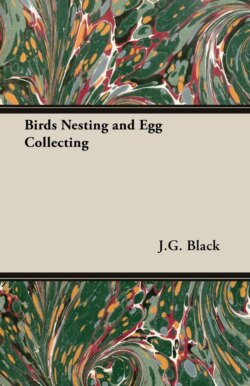Читать книгу Birds Nesting and Egg Collecting - J. G. Black - Страница 13
На сайте Литреса книга снята с продажи.
$ 3. WHEN TO LOOK.
ОглавлениеTime of Year.—It is most important to know the time of year when different birds are to be expected to lay, especially the rarer kinds for which one makes special expeditions; and the best way to make sure of this is to study the calendar at the end of the book, which will give you a good idea of the order in which to look for them, though the dates may be a good deal later than those I have given, which are “records.’’
Another useful piece of knowledge is, which birds are likely to have second broods, and that I have always given in my account of the birds themselves. You will often not be able to find a nest till the young ones are hatched, but the second nest will generally be somewhere near the first, if not in the very same place. Soon after the young have flown you should see the old birds building again, and a little patience will generally put you on the right track.
The calendar is a good rough guide, but you must watch the weather as well. For instance, if we have very wintry weather in March, the early birds may easily be a fortnight or more behind their time; but it does not follow that the summer birds, which mostly get here about the middle of April, or later, will be put back in proportion. If the weather turns warm and everything begins to grow, the later birds may be well up to time. Another year the cold snap may come after the early birds have got well started, and then it is the summer birds that will be late in arriving and behindhand with their nesting arrangements.
Birds will generally not start building until the particular cover they like has grown up enough to give them shelter, but you will often come across impatient spirits that won’t wait for this. 1 have even seen that shy bird the Corncrake busily building its nest when the grass had not grown tall enough to hide it.
Time of Day.—So much for the time of year. Now for the time of day. I think boys would agree that all day long is the best time, but most of us have other things to do, even in the holidays; while at school the time for birds nesting is generally when you can, not when you like. Still it will be useful to know what the birds are doing at different times, and the first thing to think about is that all birds are early risers, and get the best part of their day’s work over before we start ours. Now the most interesting way to study them is to watch the whole business from building (or even pairing) to hatching and fledging, and if you want to see them building, early morning is the time. They work harder then, and seem less suspicious of human beings.
Mid-day.—When the eggs are laid and the birds have begun to sit, you may find the nests of most of them at any time of the day. But there are certain birds which are very shy, and always seem to get off their nests long before you come near; then they sit about and watch you, and won’t go back to their nests however patiently you wait. You can spot every pair of Whinchats in the district, but you will have hard work to find a single nest before they start to feed their young ones.
Dusk.—Now the best way to find their nests is to mark the spot where you always see the birds, and come back at dusk. Walk quietly over all the likely ground, poking about with your stick, and if you are lucky the bird won’t leave her nest till you actually touch the tuft that covers it. This plan will serve for any birds that build on the ground and leave their nests in a hurry. I have walked right up to a Curlew on a misty evening, and walked round her at about five yards distance, and all she did was to twist her head round till I thought she would dislocate her neck; I went on and left her still sitting on her eggs. Not very like a Curlew at ordinary times, was it?
Rain.—A real wet day gives you a splendid chance for getting on terms with the shy birds, as no bird likes to leave her eggs to get wet; so you can’t do better than spend such a day on birds that have always beaten you before, perhaps a Curlew, Redshank, or Golden Plover. But wherever you go you can rely on every bird being on her nest.
Snow is even better. I was once walking over a Yorkshire moor in April, seeing lots of birds about, but not coming on many nests. Suddenly a heavy snow shower came on, and I sat down under a wall for shelter. That shower didn’t last for ten minutes, but before it was over I saw five Plovers, a Curlew and a Redshank come back to their nests on the piece of moor I could see, and also saw a Carrion Crow hurry into a little plantation in the distance. I found all their nests, and several more from which the birds rose as I topped a small rise on my way to the plantation; so you see how a little bad weather can help. Of course, with a covering of snow you can find every Plover’s nest for miles. You can see the brown patches among the white 40 yards away.
